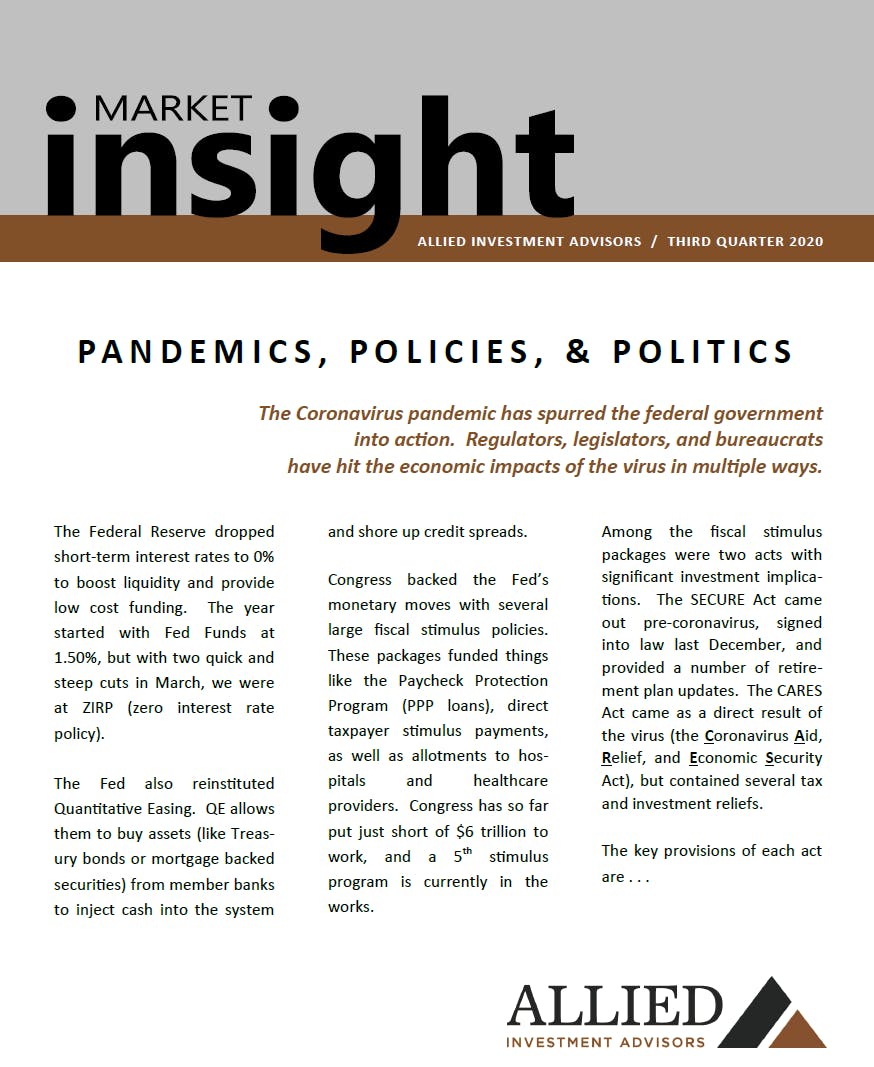Q3 2020: Pandemics, Policies, & Politics
August 6, 2020
The Coronavirus pandemic has spurred the federal government into action. Regulators, legislators, and bureaucrats have hit the economic impacts of the virus in multiple ways.
The Federal Reserve dropped short-term interest rates to 0% to boost liquidity and provide low-cost funding. The year started with Fed Funds at 1.50%, but with two quick and steep cuts in March, we were at ZIRP (zero interest rate policy).
The Fed also reinstituted Quantitative Easing. QE allows them to buy assets (like Treasury bonds or mortgage-backed securities) from member banks to inject cash into the system and shore up credit spreads.
Congress backed the Fed’s monetary moves with several large fiscal stimulus policies. These packages funded things like the Paycheck Protection Program (PPP loans), direct taxpayer stimulus payments, as well as allotments to hospitals and healthcare providers. Congress has so far put just short of $6 trillion to work, and a 5th stimulus program is currently in the works. Among the fiscal stimulus packages were two acts with significant investment implications. The SECURE Act came out pre-coronavirus, signed into law last December, and provided a number of retirement plan updates. The CARES Act came as a direct result of the virus (the Coronavirus Aid, Relief, and Economic Security Act), but contained several tax and investment reliefs.
The key provisions of each act are . . .
The SECURE Act
The SECURE Act is a legislative update designed to address longer life expectancies and provide more retirement saving options. The biggest changes with the SECURE Act:
- The required minimum distribution (RMD) age was increased from 70½ to 72. You can delay withdrawals from your IRA up to age 72 (if you haven’t already turned 70½ in 2019).
- You can continue to make IRA contributions past age 70½ as long as you are still working.
- The “stretch” IRA provision has been eliminated. Previously, if you inherited an IRA you could stretch out the required distributions over your life expectancy. The new law now limits the withdrawal period to 10 years (in most cases, with a few notable exceptions for surviving spouses, minor children, etc.).
- There were numerous other provisions in the act, including tax credits for starting a retirement plan, IRA withdrawals for the birth of a child, and allowing 529 plans to pay down $10,000 of student loan debt.
- The act also focused on improving “lifetime income investments” in 401(k) plans. These are better known as annuities. This is a nice option to have in a 401(k) plan – it can provide a stable, monthly payout to participants – but annuities have a history of being high cost and overly complex, so we would advise detailed due diligence before moving forward.
The CARES Act
The CARES act is less a legislative overhaul and more a package designed to stimulate the economy through the COVID pandemic. The biggest line items were:
- The headline of the CARES Act was the direct economic impact payments to Americans (up to $1,200 per adult).
- The PPP (payroll protection plan) loan program targeted small businesses with forgivable loans.
- More specific to investing, a number of retirement account rules were relaxed.
- Required Minimum Distributions (RMDs) for 2020 were suspended. This includes any retirement account subject to RMDs, such as IRAs, 401(k)s, and inherited accounts. If you have already taken your 2020 RMD, you have until August 31st to re-contribute the amount back into your account.
- The CARES Act also allows you to take up to $100,000, in certain circumstances, from your retirement accounts penalty-free (for those under age 59½), along with tax deferment or repayment options over a 3-year period. While this provides a nice emergency option, taking funds from your retirement account should only be considered as a last measure in most financial planning scenarios.

The year is not over, and Congress may come out with additional fiscal stimulus plans. They are currently debating a 5 th stimulus package. Early indications are that it will contain another round of direct stimulus checks to individuals. Other items, including school funding and enhanced unemployment benefits, are sticking points between the parties.
While it’s been a busy year for the folks in Washington, let’s not forget the main event. We are less than three months from a federal election.
While we are not political pundits (you’re welcome), we are investors with a keen eye on market history. Data from the last 100 years shows that conventional wisdom – how the market reacts to politics – may be backwards. When it comes to Presidential Elections, the stock market may play an important role in the outcome.
There is a simple rule that has predicted a majority of the elections over the last century:
- When the market rallies in the 90 days leading up to election, the incumbent party usually wins.
- When the market falls in the 90 days leading up to election, the challenging party usually wins.
87% of the time since 1928 – 20 of 23 election cycles – this indicator has proven correct.
It worked in 1928 when a rising market forecast a win for incumbent candidate Herbert Hoover. It worked in 1932 when a falling market forecast a win for challenger Franklin Roosevelt. And it worked in 2016, when nearly every national poll – 112 of 114 – was wrong and showed Hillary Clinton defeating Donald Trump. Yet from August to early November 2016, the market was down -1.65%. This favored the challenger (Republican/Trump) and proved correct.
So this fall, rather than focus on the incessant political ads, the polls, or even the debates, you may be better off watching the market. The old saying that Americans vote their pocketbooks may be truer than you know.
If you have any questions about your account(s), or if there has been a change in your financial situation or investment objectives, please feel free to contact any member of our team to schedule a meeting.

